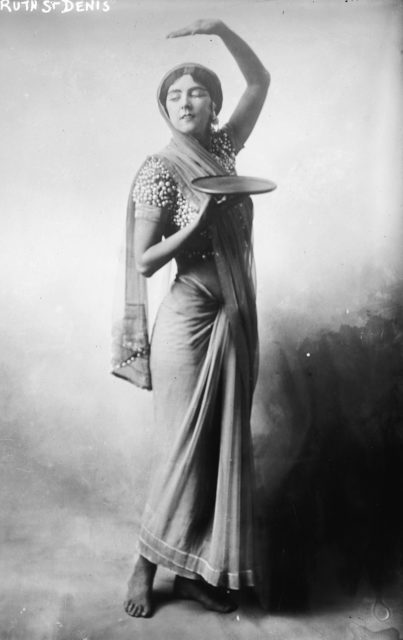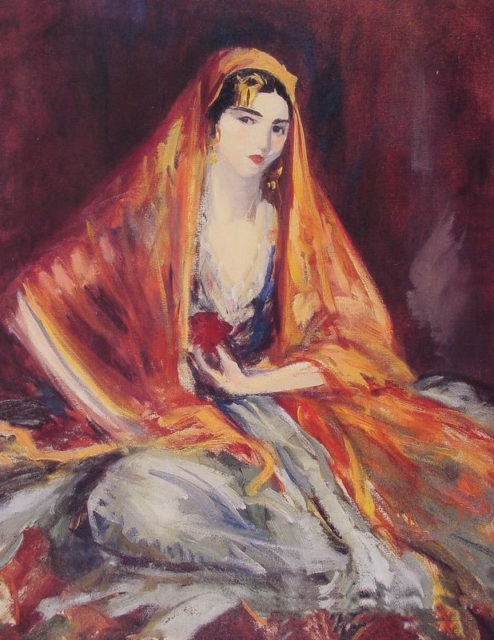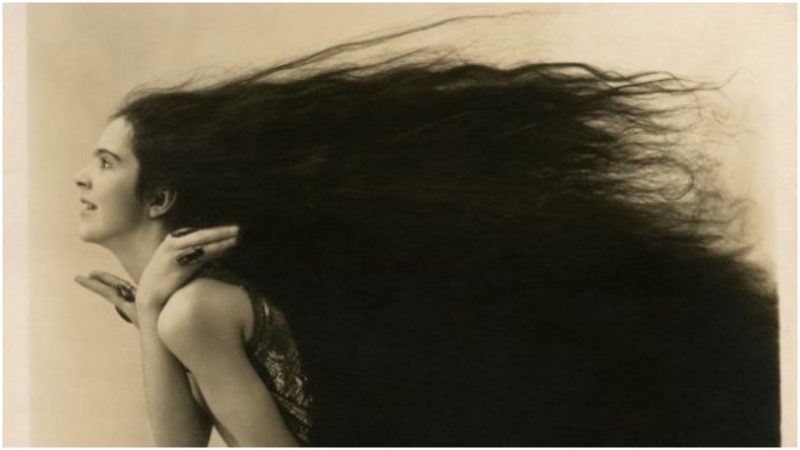In the early 20th century certain dancers sought to popularize modern dance as a separate branch from the strict classical ballet. Dancers wanted to see what was “beyond dance,” and worked hard to improve their techniques and create unique styles. Many of them turned their attention to the East, studying the traditional Asian dances in India, Arabia, and China. When they brought them back to the West, these dances were modified by the performers themselves into a unique, theatrical sensation. There are many fascinating characters among the pioneers of modern dance, such as Isadora Duncan, Loie Fuller, Ted Shawn, and many others who brought the art of dance to another level.
There are two dancers from that era who have frequently been compared to each other due to their styles: the American dancer, Ruth St. Denis and the British performer, Olive Katherine Craddock, known by her stage name, Roshanara, born and raised in India. While the former was inspired by photos of Egyptian goddesses and wanted to imitate Oriental dances in her own style, the latter was raised in the spirit of Indian culture, and she was trained to perform the Oriental style dance to perfection, and again, in her own manner.
Ruth St. Denis was already an accomplished dancer, and while touring in 1904 with the famous producer and director David Belasco, she saw a poster of the Egyptian goddess Isis, portrayed enthroned in a temple to advertise the Egyptian Deities cigarettes. St. Denis fell under the spell of the poster, which she found so powerful that she made a spontaneous decision to create dances that would express the kind of mysticism she saw in the poster. From that moment on, the dancer studied Oriental philosophies, art, and dances.

In the meantime, the 15 years’ younger Craddock was enjoying the privileges of her upper-class British background in India. She was born and raised in the country, where she studied Indian culture and was trained in Oriental dances since she was a child. In 1909, Craddock moved to Britain and adopted the name Roshanara, after the Indian princess Roshanara Begum. Her fame spread once she entered the theaters of Covent Garden and Ballets Russes.
She soon performed side by side with Loie Fuller and was trained by the Spanish dancer Carmen Tórtola Valencia. Two years after moving to London, she performed in Kismet by Oscar Asche and as Zobeide in Scheherazade. In 1912, Roshanara became a specialty dancer in Anna Pavlova’s dance company. For a few of the dances she performed, Roshanara used extracts from Lakmé, an Oriental opera from the 1880s by the French composer Léo Delibes.
On the other hand, St. Denis was on her own, studying Hindu mythology without teachers and lecturers by her side. And, a few years before Roshanara moved to Britain, Ruth performed in the role of Krishna’s mortal love, the maid Radha, a myth originally presented to music from the same opera which her colleague used, Léo Delibes’ Lakmé. St. Denis’ choreography and dancing style were not necessarily accurate or authentic culturally, but she certainly enchanted the audience with it and gained the status of celebrity. She strongly believed that the art of dancing was a spiritual expression, which she managed to show with her movements and the people loved it.
After her success on the British scene, in 1916 Craddock moved to the United States and performed in vaudeville theaters. Besides being a specialty dancer along with the Japanese dancer Michio Itō in Ballet Intime, the company of Adolf Bolm, she also performed with Ratan Devi, a British singer who studied music in India. During this time, Devi’s husband, Ananda Coomaraswamy, an expert on Indian culture employed at the Boston Museum of Art, accompanied the performing duo and wrote about the authenticity of Roshanara. He compared her as a contrast to Ruth St. , whose Indian style dance he found to be inaccurate.
Nevertheless, St. Denis continued to work and perform in her style. She married her much younger colleague, the dancer Ted Shawn, and together they established the famous Denishawn school in Los Angeles, known as the “cradle of American modern dance.” Among the many dancers who studied there was Martha Graham, who was taught by St. Denis. Their careers blossomed, and they were devoted artists, developing the art of dance to another level. Although many were obsessed with the authenticity of the Indian style of dance, as a dancer and mentor of others, St. Denis respected Craddock and followed her career.

Deborah Jowitt argued that the famous dances of Roshanara might not have been learned in India, as she claimed, due to the significant similarity to St. Denis’ style, which she performed years before Craddock. Jowitt believes that Craddock might have had the opportunity of seeing St. Denis perform on some occasion and studied her techniques, later adopting them as her own. But whether St. Denis mastered the style so well only to appear similar to the “original technique” performed by Roshanara, or whether the latter really “stole” the technique is now irrelevant. Both of them were beautiful and successful dancers.
Sadly, Roshanara didn’t live long enough to continue blossoming on stage; she died in her thirties from appendicitis. St. Denis continued to perform and to instruct young dancers, of whom many became very famous.
